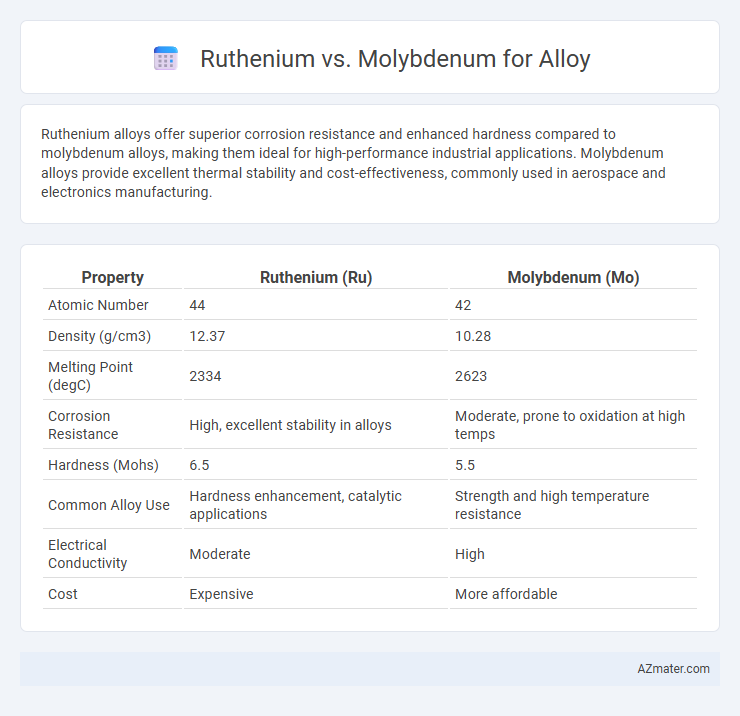Ruthenium alloys offer superior corrosion resistance and enhanced hardness compared to molybdenum alloys, making them ideal for high-performance industrial applications. Molybdenum alloys provide excellent thermal stability and cost-effectiveness, commonly used in aerospace and electronics manufacturing.
Table of Comparison
| Property | Ruthenium (Ru) | Molybdenum (Mo) |
|---|---|---|
| Atomic Number | 44 | 42 |
| Density (g/cm3) | 12.37 | 10.28 |
| Melting Point (degC) | 2334 | 2623 |
| Corrosion Resistance | High, excellent stability in alloys | Moderate, prone to oxidation at high temps |
| Hardness (Mohs) | 6.5 | 5.5 |
| Common Alloy Use | Hardness enhancement, catalytic applications | Strength and high temperature resistance |
| Electrical Conductivity | Moderate | High |
| Cost | Expensive | More affordable |
Introduction to Ruthenium and Molybdenum in Alloys
Ruthenium and molybdenum are critical elements used to enhance the mechanical properties and corrosion resistance of alloys. Ruthenium, a rare transition metal, significantly improves hardness, wear resistance, and oxidation resistance, making it valuable for high-performance alloys in electronics and aerospace applications. Molybdenum, known for its high melting point and strength, is frequently alloyed to increase toughness and thermal stability, especially in steel and superalloys for industrial machinery and structural components.
Chemical Properties: Ruthenium vs Molybdenum
Ruthenium exhibits exceptional corrosion resistance and maintains stability at high temperatures due to its hexagonal close-packed crystal structure and strong chemical inertness, making it ideal for enhancing alloy durability. Molybdenum, with a body-centered cubic structure, offers high melting points and excellent strength, particularly in reducing environments, but is more susceptible to oxidation compared to ruthenium. The chemical bonding in ruthenium favors improved hardness and resistance to wear, while molybdenum's ability to form stable carbides contributes to alloy toughness and thermal stability.
Mechanical Strength and Durability Comparison
Ruthenium alloys exhibit superior mechanical strength and enhanced wear resistance compared to molybdenum alloys, making them ideal for high-stress applications requiring durability under extreme conditions. Molybdenum, while offering excellent thermal stability and impact resistance, generally falls short of ruthenium in hardness and fatigue endurance. The combination of ruthenium's high melting point and corrosion resistance allows alloys to maintain structural integrity longer than molybdenum-based counterparts in harsh environments.
Corrosion and Oxidation Resistance
Ruthenium exhibits superior corrosion resistance compared to molybdenum, especially in aggressive acidic environments, due to its stable oxide layer that prevents further degradation. Molybdenum enhances steel alloys by improving resistance to pitting and crevice corrosion in chloride-rich atmospheres but is less effective against high-temperature oxidation. Alloys containing ruthenium maintain structural integrity longer under oxidative stress, making them ideal for applications requiring prolonged exposure to harsh chemical and thermal conditions.
Electrical and Thermal Conductivity
Ruthenium exhibits higher electrical conductivity than molybdenum, making it advantageous for alloy applications requiring efficient electron flow, such as in electrical contacts and resistors. Molybdenum, however, offers superior thermal conductivity and excellent high-temperature stability, which enhances heat dissipation in alloys used for aerospace and industrial furnaces. Alloys combining ruthenium and molybdenum can balance electrical performance with thermal management, optimizing material properties for advanced electronic and thermal applications.
Cost and Availability of Ruthenium and Molybdenum
Ruthenium is significantly more expensive and less abundant than molybdenum, making it a costlier choice for alloy production. Molybdenum is widely available, with large-scale mining operations ensuring stable supply and competitive pricing. The scarcity of ruthenium, primarily sourced as a byproduct of platinum and nickel mining, limits its use to specialized applications where its unique properties justify the higher cost.
Popular Alloy Applications: Industry Use Cases
Ruthenium is commonly used as an alloying element in platinum and palladium-based alloys to enhance hardness and corrosion resistance, especially in electrical contacts and high-performance jewelry. Molybdenum is widely incorporated into steel alloys to improve strength, hardness, and resistance to corrosion and wear, making it essential for aerospace, automotive, and construction industries. Both metals are critical for advanced alloy applications, with ruthenium favored for electronic and catalytic uses, while molybdenum dominates structural and high-temperature alloy compositions.
Environmental Impact and Recycling Potentials
Ruthenium alloys exhibit lower environmental impact during extraction due to limited mining activities compared to molybdenum, which is more widely mined with higher associated greenhouse gas emissions. Molybdenum demonstrates greater recycling potential with established infrastructure to recover it from scrap steel and other alloys, whereas ruthenium recycling remains less developed due to its rarity and specialized use in electronics and catalysts. Both metals offer durability and corrosion resistance, but molybdenum's recycling efficiency significantly reduces the need for primary mining, enhancing its sustainability profile in alloy applications.
Future Trends in Alloy Development
Ruthenium and molybdenum alloys are gaining traction in high-performance applications due to their exceptional hardness, corrosion resistance, and thermal stability. Future trends in alloy development emphasize ruthenium's catalytic properties and ability to enhance wear resistance in superalloys, while molybdenum's role in improving strength and creep resistance remains vital for aerospace and energy sectors. Emerging research focuses on optimizing these elements' concentrations to create cost-effective, durable alloys tailored for extreme environments.
Conclusion: Choosing the Right Element for Alloys
Ruthenium offers superior corrosion resistance and hardness, making it ideal for high-performance, wear-resistant alloys in electronics and aerospace applications. Molybdenum provides excellent strength and thermal stability at a lower cost, suitable for structural and industrial alloys exposed to high temperatures. Selecting between ruthenium and molybdenum depends on balancing performance requirements with budget constraints and environmental conditions.

Infographic: Ruthenium vs Molybdenum for Alloy
 azmater.com
azmater.com